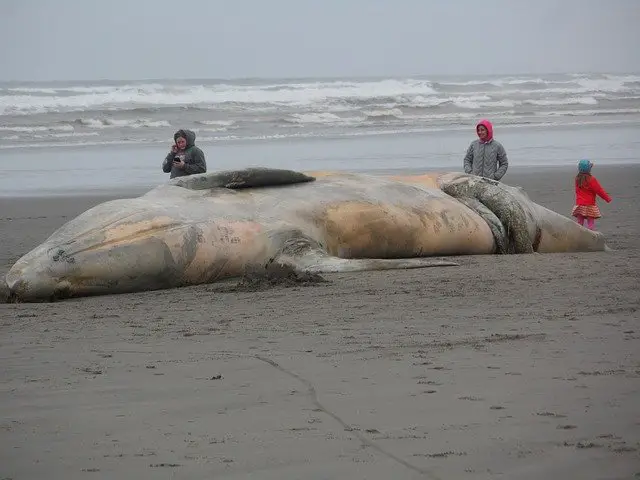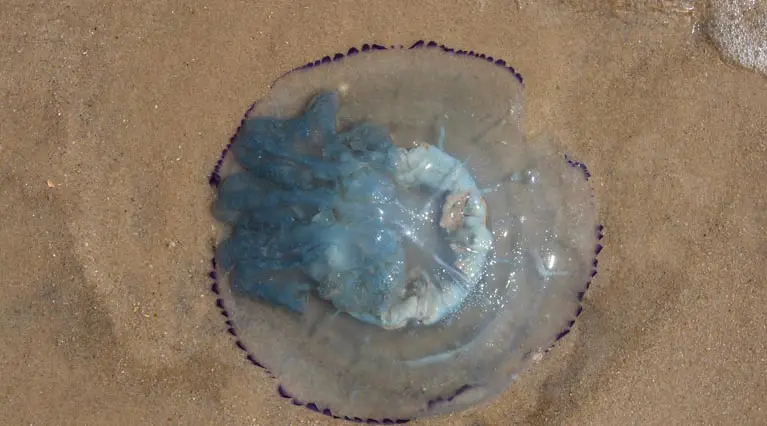Last modified on November 12th, 2021 at 9:36 am
“A Wallpaper of Blue” Jellyfish Beaching
Visitors at Deception Bay, a beach located just north of Brisbane, Australia, had quite a shocking encounter when they arrived one morning. Thousands of beached Jellyfish bodies coated the sand. And while this species of jellies, the Blue Blubber Jellyfish, is common among this Australian coastline, the size of this deceased bloom (large group of jellyfish) had even the top marine experts in the area puzzled.
Marine biologist Dr. Lisa Ann Gershwin, whose main field of study is Jellyfish, said this was the biggest bloom washed ashore she had seen in her 25 years of research. And while beaching’s are a normal part of the jellyfish life cycle, this massive amount of stranded bodies demanded an explanation.
“I can honestly say it’s the most incredible stranding I’ve seen anywhere — and I’ve seen a lot of stranding’s, just gob smacking,”
Dr. Lisa Ann Gershwin was quoted when asked about the event.
Fortunately, this mass stranding of Blue Blubber Jellyfish isn’t seen to have any sort of negative effect on the local ecosystem or Blue Blubber Population though. Without water to support their bodies, the jellyfish will dry up and become a food source for bird and turtles.
Blue Blubber Jellyfish Facts:
The Blue Blubber Jellyfish ranges in color from light blue, and to as dark as burgundy. But in their juvenile stage of life they can appear pale and white. Blue Blubber’s are native to coastal lagoons near eastern Australia and this jellyfish can vary in size with their ‘Bells’ growing up to 12 to 18 inches in length. They have eight arms that are covered in small tentacles and mouths, that are used to transport their food to their stomachs.
The Blue Blubber also has a symbiotic relationship with certain algae, which helps to provide nutrients for the jelly. The algae are only beneficial to the Blue Blubber while it is photosynthesizing, and at night it turns back into a predator and begins its hunt.
Their tentacles have small stinging cells or ‘nematocysts’ they use to catch their prey, which consist of small fish and tiny crustaceans. These nematocysts are a small tube like contraption that uses tiny points to pump poison into anything that get tangles up in its arms.
And while this poison is ultimately fatal for the Blue Blubber Jellyfishes unsuspecting prey, compared to the deadlier jellyfish, such as the Box Jellyfish (also known as the world’s most deadly jellyfish) if a human gets too close, the effect is minor. Usually resulting in redness and itching, and at worse an allergic reaction.
Like all jellyfish species, the Blue Blubber also does not have a brain, but a net of nerves that flows throughout its body. The nerves in the ball of the jelly cause propulsions which cause the jellyfish to move, and they tend to be slow moving, which is good news for swimmers since they are easily avoidable. Juvenile Blue Blubber Jellyfish can even be seen followed around by small groups of fish as they make their way through the water.
Blue Blubber Jellyfish are also commercially harvested in Australia. They are commonly eaten in Asian countries as a delicacy. Once it is dried and properly processed the jellyfish can be safely eaten and is believed to reduce high blood pressure.
Marine Animal Beaching’s – Why Do They Happen and What/Who’s to Blame?
Many species of marine life are seen to beach themselves. Most common is whales and dolphins. In fact, a massive beaching of Pilot whales recently occurred in New Zealand in February of 2017, which resulted in twenty of the whales having to be euthanized die to injuries, and only about 100 of the whales able to be saved and moved back out to sea.
While the beaching of the Blue Blubber Jellyfish is seemed to be mainly a factor of overpopulation due to lack of predators, warm weather, and changes in the current, reports of a strong east northerly wind could have also been linked to this mass beaching of jellyfish. This caused an increase of sightings of multiple jellyfish, which included the Blue Blubber, along with the Bluebottle Jellyfish.
While jellyfish beaching’s may be merely just due to overpopulation and strong wind patterns, it is still unknown for sure why other marine life exhibit this odd behavior. It has even been recorded that the same animal will beach itself multiple times. This leads some researchers to theorize that this is an almost suicidal attempt when an animal is injured or unable to hunt anymore, and just lets itself get stranded since it doesn’t have the energy to continue living. But this theory doesn’t explain the large amounts of whale pods that show up on shore.

Sonar and Noise Pollution in the Ocean:
A few more recent theories attempting to explain these mysterious beaching’s have been under investigation. Sonar, which was developed by the U.S Navy for detecting enemy submarines, has been under scrutiny for years, since it is believed to be correlated with the increase in these massive strandings.
A necropsy on one out of six stranded humpback whales was done in 2015 and signs of muscle hemorrhaging were found. This is a common condition observed in marine mammals involved in sonar related deaths. This injury is also seen in incidents of blunt force, such as in a collision with a ship, so it is still unclear if sonar was the main cause of death.
The IFAW (the International Fund for Animal Welfare) Has had many lawsuits against the U.S Navy in attempts for regulations involving sonar to be put in place to protect Marine Life and prevent populations from decreasing, considering many of these whales, including the Humpbacked Whale, are on the endangered species list.
While the ongoing debate of whether naval sonar is causing these beaching’s continue, researchers also believe deep sea drilling could be a culprit as well. It appears any sort of noise pollution can disrupt the whales internal compass, and echolocation, and cause bleeding of the brain, confusion, and mess up migration patterns.
And while this mystery is investigated, one thing known for sure is that human activity in these creature’s habits have a big part in this increased amount of dead marine life.
Solar Storms and the Magnetic Field
NASA has also just recently teamed up with the federal Bureau of Ocean Energy Management (BOEM) and the International Fund for Animal Welfare (IFAW) to study if a link between how solar storms effect the magnetic poles of the Earth, a hypothesized reason of why these mass strandings happen. They noticed that most cases of these beachings happen in the same areas, must commonly Australia, coasts of New Zealand, and Cape Cod, Massachusetts. All these beaches also feature the same geological conditions and scientists wonder if this is a factor into the explanation as well. They theorize that solar storms may cause shifts in the earth’s magnetic field and throw off the internal compass of the whales and dolphins, which is why they end up stranded.
Based off this information, and the massive amount of research about solar activity from NASA’s databases, these researchers hope to find a correlation between these two events in hopes to be able to save more of these animals and foresee future stranding’s.
And while the beaching of the Blue Blubber Jellyfish may have just been due to accidental or environmental factors, it opens a new discussion to why these beaching’s of marine life are happening at a higher rate, and what can be done to hopefully prevent them.
Katie Moore, director of the global Animal Rescue Program belonging to IFAW sees this project as a valuable effort in conservation. She is quoted:
“This would allow stranding responders in global hotspots, and really around the world, to be better prepared to respond, thus having the opportunity to save more animals.”
With a background in business and Wildlife ecology I have been a nature enthusiast all my life. If I’m not writing, I can be found buying too many books, hiking, or cuddling my pet Degu.




